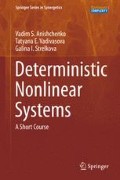Abstract
We consider a class of autonomous continuous-time dynamical systems with phase space dimension N ≥ 3. Besides robust systems similar to Andronov–Pontryagin systems on the plane, there appears a class of robust systems with nontrivial hyperbolicity, i.e., systems with chaotic dynamics. Chaotic attractors of robust hyperbolic systems are, in the rigorous mathematical sense, strange attractors. They usually represent some mathematical idealization and are not as a rule observed in experiments. In most cases systems with irregular dynamics are nonrobust. Mathematicians have proven that robust hyperbolic systems are not everywhere dense on the set of dynamical systems with N ≥ 3. Structural instability (nonrobustness) is associated with the emergence of nonrobust double-asymptotic trajectories, such as separatrix loops, homoclinic curves, and heteroclinic curves, which are formed when manifolds of saddle cycles and another saddle sets intersect non-transversally.
Access this chapter
Tax calculation will be finalised at checkout
Purchases are for personal use only
Notes
- 1.
The nonwandering set of a DS is the set of all nonwandering points in phase space. A point is nonwandering if, for any specified time interval θ, under the action of the evolution operator, any neighborhood of this point crosses its original position in a time τ > θ. Points of limit sets are nonwandering. However, the notion of nonwandering sets, unlike limit sets, is applicable to conservative systems. It should also be noted that the notion of a nonwandering point is somewhat different from the notion of a point that is stable according to Poisson. Obviously, Poisson-stable points are nonwandering, but the converse statement is not always true. For example, separatrix loops in the plane consist of nonwandering points but double-asymptotic trajectories that are components of them are not Poisson-stable.
- 2.
This implies that periodic trajectories are everywhere dense in Ω.
- 3.
See, for example, Kuznetsov [12].
- 4.
Due to certain specifics of the calculation algorithm, the probability is set to zero if the phase trajectory has no unstable manifold.
References
Afraimovich, V.S., Arnold, V.I., Ilyashenko, Yu.S., Shilnikov, L.P.: Dynamical Systems V. Encyclopedia of Mathematical Sciences. Springer, Heidelberg (1989)
Afraimovich, V.S., Shilnikov, L.P.: Strange attractors and quasiattractors. In: Barenblatt, G.I., Iooss, G., Joseph, D.D. (eds.) Nonlinear Dynamics and Turbulence, p. 1. Pitman, Boston (1983)
Anishchenko, V.S.: Dynamical Chaos – Models and Experiments. World Scientific, Singapore (1995)
Anishchenko, V.S., Astakhov, V.V., Neiman, A.B., Vadivasova, T.E., Schimansky-Geier, L.: Nonlinear Dynamics of Chaotic and Stochastic Systems. Springer, Berlin (2002)
Arnold, V.I.: Additional Chapters of the Theory of Differential Equations. Nauka, Moscow (1978) (in Russian)
Barreira, L., Pesin, Y.: Nonuniform Hyperbolicity: Dynamics of Systems with Nonzero Lyapunov Exponents. Encyclopedia of Mathematics and Its Applications. Cambridge University Press, Cambridge (2007)
Bowen, R.: Equilibrium States and the Ergodic Theory of Anosov Diffeomorphisms. Lecture Notes in Mathematics, vol. 470. Springer, Berlin (1975)
Devaney, R.L.: An Introduction to Chaotic Dynamical Systems. Westview, Boulder (1989, 2003)
Feudel, U., Kuznetsov, S., Pikovsky, A.: Strange Nonchaotic Attractors: Dynamics Between Order and Chaos in Quasiperiodically Forced Systems. World Scientific, Singapore (2006)
Guckenheimer, J., Holmes, P.: Nonlinear Oscillations, Dynamical Systems, and Bifurcations of Vector Fields. Springer, New York (1983)
Katok, A., Hasselblatt, B.: Introduction to the Modern Theory of Dynamical Systems. Cambridge University Press, Cambridge (1995)
Kuznetsov, S.P.: Dynamical chaos and uniformly hyperbolic attractors: from mathematics to physics. Phys. Uspekhi 181(2), 121–149 (2011)
Lichtenberg, A., Lieberman, M.A.: Regular and Stochastic Motion. Springer, New York (1983)
Zaslavsky, G.M.: Chaos in Dynamical Systems. Harwood, New York (1985)
Author information
Authors and Affiliations
Rights and permissions
Copyright information
© 2014 Springer International Publishing Switzerland
About this chapter
Cite this chapter
Anishchenko, V.S., Vadivasova, T.E., Strelkova, G.I. (2014). Robust and Nonrobust Dynamical Systems: Classification of Attractor Types. In: Deterministic Nonlinear Systems. Springer Series in Synergetics. Springer, Cham. https://doi.org/10.1007/978-3-319-06871-8_8
Download citation
DOI: https://doi.org/10.1007/978-3-319-06871-8_8
Published:
Publisher Name: Springer, Cham
Print ISBN: 978-3-319-06870-1
Online ISBN: 978-3-319-06871-8
eBook Packages: Physics and AstronomyPhysics and Astronomy (R0)

